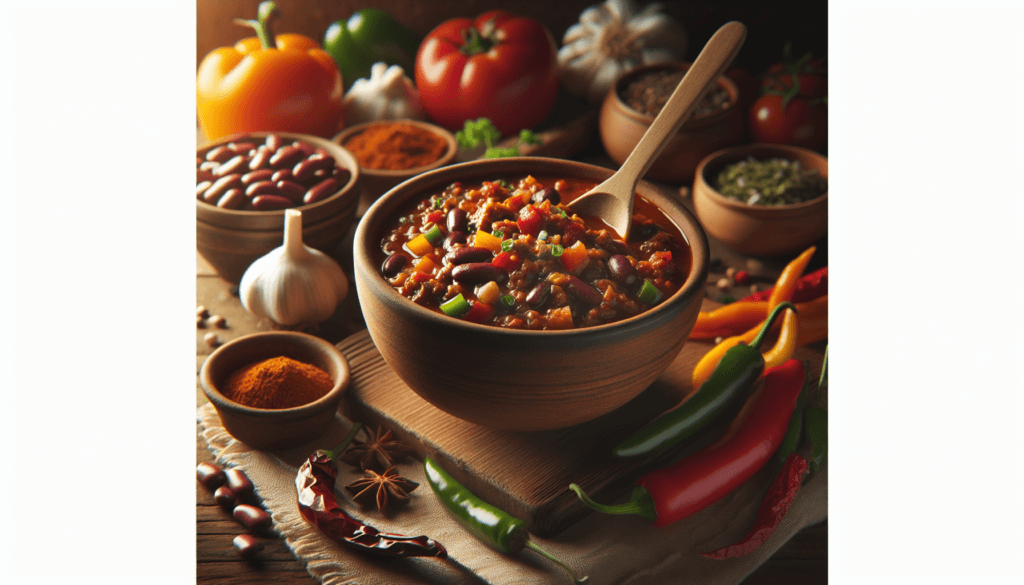Are you craving a warm and comforting bowl of homemade chili but not sure where to start? Look no further! In this article, we will share some easy and delicious recipes for homemade chili that can be whipped up in no time. Whether you prefer a classic beef chili or want to explore vegetarian options, we have got you covered. Get ready to tantalize your taste buds with these simple yet flavorful chili recipes that will have you coming back for seconds.

Choosing the Meat
When it comes to making homemade chili, the first step is choosing the right meat. There are a few options you can consider, depending on your dietary preferences and taste preferences.
Ground Beef
Ground beef is a classic choice for chili. It provides a hearty and rich flavor that many people love. You can choose a leaner ground beef for a healthier option, or opt for a fattier cut if you want a more indulgent chili. Keep in mind that the fat from the beef can add flavor and richness to your chili.
Ground Turkey
If you are looking for a healthier alternative to ground beef, ground turkey can be a great choice. It is leaner and lower in fat, but still provides a good amount of protein. Ground turkey can be a bit milder in flavor compared to beef, so you may want to add some extra spices and seasonings to make your chili more flavorful.
Vegetarian Options
For those who follow a vegetarian or vegan diet, there are plenty of options to make a delicious meatless chili. You can use plant-based ground meat substitutes, such as soy crumbles or textured vegetable protein (TVP), which can mimic the texture and flavor of ground beef. Another option is using a variety of beans as the base for your chili, like kidney beans, black beans, or pinto beans. These beans not only provide protein but also add a nice texture to your chili.
Base Ingredients
Before you start adding the flavors and spices to your chili, it’s important to have a good base of ingredients. These foundational ingredients will form the backbone of your chili and add depth of flavor.
Chili Powder
Chili powder is an essential ingredient in any chili recipe. It is a blend of spices, usually including ground chili peppers, cumin, garlic powder, and other seasonings. Chili powder adds a rich and smoky flavor to your chili. You can find chili powder in most grocery stores, or you can make your own blend by mixing together ground chili peppers, cumin, paprika, and other spices.
Cumin
Cumin is another key ingredient in chili. It has a warm and earthy flavor that pairs well with the richness of the meat and the spiciness of the chili powder. Ground cumin can be found in the spice aisle of your grocery store. Adding cumin to your chili will give it a distinctive aroma and depth of flavor.
Onion
Onions are a staple in many savory dishes, and chili is no exception. They add a sweet and savory flavor to your chili, as well as some texture. You can use yellow onions, white onions, or red onions, depending on your preference. Chopped onions can be sautéed with the meat or added directly to the chili while it simmers.
Garlic
Garlic is another aromatic ingredient that can elevate the flavor of your chili. It adds a subtle yet distinct taste, and its pungent aroma is always a welcome addition. You can use fresh garlic cloves, which are minced or crushed, or use garlic powder if you prefer a milder garlic flavor.
Beans
Beans are often included in chili recipes to add texture, fiber, and additional protein. Common choices include kidney beans, pinto beans, and black beans. You can use canned beans for convenience or cook dried beans from scratch for a more homemade touch. Beans not only make your chili heartier but also help balance the flavors and add a creamy texture.
Variation with Vegetables
Vegetables are a great way to add extra flavor, texture, and nutritional value to your chili. Here are some vegetables that work well in chili recipes.
Bell Peppers
Bell peppers come in a variety of vibrant colors and add a hint of sweetness to your chili. They also provide a satisfying crunch and visual appeal. You can use green, red, yellow, or orange bell peppers, or even a mix of different colors. Simply chop the bell peppers into small pieces and add them to your chili during the cooking process.
Corn
Corn adds a touch of sweetness and bright color to your chili. You can use fresh, canned, or frozen corn kernels, depending on what’s available and your personal preference. If using fresh corn, you can cut the kernels off the cob, while canned or frozen corn can be added directly to the chili. Corn not only adds flavor but also adds a nice texture contrast to the meat and beans.
Zucchini
Zucchini is a versatile vegetable that can be used in a variety of dishes, including chili. It has a mild flavor and a slightly crisp texture. You can chop the zucchini into small pieces and add it to your chili when you sauté the onions and garlic. Zucchini will not only add some extra nutrients to your chili but also help keep it moist and flavorful.
Carrots
Carrots can be a surprising addition to chili, but they add a lovely sweetness and earthiness. They also add a vibrant orange color to your chili. You can grate the carrots or chop them into small pieces and add them to your chili along with the other vegetables. Carrots add a subtle sweetness that balances the spiciness and richness of the chili.
Spice up Your Chili
If you like your chili with a kick of heat, there are several spicy ingredients you can add to take it up a notch.
Jalapenos
Jalapenos are a popular chili pepper that adds a mild to moderate level of heat to your dish. They also have a distinct flavor that pairs well with the other ingredients in chili. You can finely chop jalapenos and add them to your chili for some extra spice. Remember to remove the seeds and stems before adding them to your chili if you prefer less heat.
Cayenne Pepper
Cayenne pepper is known for its fiery heat and intense flavor. A little goes a long way, so use it sparingly if you’re not a fan of extreme spice. You can add a pinch of cayenne pepper to your chili for some extra heat. Adjust the amount according to your taste preferences, and remember that the heat will intensify as the chili simmers and flavors meld together.
Hot Sauce
Hot sauce is a convenient way to add both heat and flavor to your chili. There are countless varieties of hot sauces available, ranging from mild to extremely spicy. You can add a few dashes of your favorite hot sauce to your chili during the cooking process, or you can serve it on the side for individuals to customize the spice level of their bowl.

Add Some Sweetness
To balance out the heat and richness of your chili, adding a touch of sweetness can bring a delightful contrast of flavors. Here are some sweet ingredients you can incorporate into your recipe.
Brown Sugar
Brown sugar adds a deep and caramel-like sweetness to your chili. You can add a small amount of brown sugar to your chili towards the end of the cooking time, taste, and adjust as needed. The sweetness of brown sugar helps mellow out the spiciness and adds complexity to the overall flavor profile of your chili.
Honey
Honey is a natural sweetener that can add a subtle floral flavor to your chili. It is a versatile ingredient that can balance the heat and acidity of the other ingredients. You can drizzle a bit of honey into your chili during the simmering process. Start with a small amount, taste, and adjust as needed to achieve the desired level of sweetness.
Maple Syrup
Maple syrup adds a distinct and rich sweetness to your chili. It pairs particularly well with smoky flavors and can bring a touch of warmth to your dish. You can add a small amount of maple syrup to your chili towards the end of the cooking time. Be mindful not to overdo it, as a little goes a long way in adding a delightful sweetness.
Enhancing Flavors with Herbs and Spices
In addition to the foundational ingredients, herbs and spices can elevate the overall flavor profile of your chili. Here are some common herbs and spices that work well in chili recipes.
Oregano
Oregano is an herb with a robust and slightly bitter flavor. It adds a savory and earthy note to your chili. You can use dried oregano by adding it during the cooking process. Start by adding a teaspoon of dried oregano and adjust to your taste preferences.
Bay Leaves
Bay leaves are aromatic and add a subtle floral flavor to your chili. They are usually added at the beginning of the cooking process, and their flavor infuses into the chili as it simmers. Remember to remove the bay leaves before serving your chili, as they are not meant to be eaten.
Cayenne Pepper
Cayenne pepper not only adds heat but also enhances the overall flavor of your chili. It has a distinct spiciness and a touch of smokiness. You can add a pinch of cayenne pepper to your chili along with the other spices, or adjust the amount to your heat preference.
Paprika
Paprika is a spice made from ground dried peppers, usually made from sweet or smoked peppers. It adds a rich and vibrant color to your chili, as well as a smoky and slightly sweet flavor. You can use sweet paprika or smoked paprika, depending on the flavor profile you prefer.

Perfecting the Texture
The texture of your chili is just as important as the flavor. Achieving the perfect consistency can make your chili more enjoyable to eat. These ingredients will help you achieve that desired texture.
Crushed Tomatoes
Crushed tomatoes are a staple ingredient in chili. They provide a thick and hearty base and help bind all the flavors together. You can use canned crushed tomatoes or make your own by crushing whole peeled tomatoes. The acidity of crushed tomatoes also helps balance out the richness of the meat and spices.
Tomato Sauce
Tomato sauce is another option for adding richness and depth to your chili. It has a slightly smoother consistency compared to crushed tomatoes. Tomato sauce is readily available in most grocery stores, or you can make your own by simmering fresh tomatoes and blending them until smooth.
Tomato Paste
Tomato paste is a concentrated tomato product that adds a deep and intense tomato flavor to your chili. It has a thick consistency and is usually added at the beginning of the cooking process to enhance the flavors. Tomato paste is available in cans or tubes and can be found in the canned tomato aisle of your grocery store.
Beef Broth
Beef broth can be used to add additional flavor and moisture to your chili. It is especially useful if you are using lean ground beef or turkey, which may be drier compared to fattier cuts. You can use store-bought beef broth or make your own by simmering beef bones, vegetables, and spices. Adding beef broth gradually as your chili simmers will help achieve the ideal consistency.
Toppings for Garnish
Garnishing your chili adds a final touch of flavor, texture, and visual appeal. Here are some popular toppings to consider when serving your chili.
Shredded Cheese
Shredded cheese, such as cheddar or Monterey Jack, adds creaminess and a savory element to your chili. The cheese melts on top of the hot chili and creates a delicious gooey layer. You can sprinkle a generous amount of shredded cheese on each serving of chili, allowing it to melt and mingle with the other flavors.
Sour Cream
Sour cream provides a cool and tangy contrast to the heat of the chili. It adds a creamy and rich component that complements the flavors. You can dollop a spoonful of sour cream on top of your chili, or swirl it into the chili just before serving.
Cilantro
Cilantro is a bright and refreshing herb that adds a pop of freshness to your chili. It has a distinct citrusy flavor that pairs well with the rich and savory flavors. Sprinkle some chopped cilantro on top of your chili to add a burst of color and a fragrant note.
Green Onions
Green onions, also known as scallions, can add a mild onion flavor and a hint of crunch to your chili. They add a pop of color and freshness as a topping. Finely chop some green onions and sprinkle them on top of your chili for a finishing touch.

Serving Suggestions
While a bowl of chili is delicious on its own, you can get creative and use it as a base for other dishes. Here are some serving suggestions to try.
Chili Dogs
Chili dogs are a classic American comfort food. Simply grill some hot dogs, place them in a toasted bun, and top them with a generous amount of chili. Add your favorite toppings, such as shredded cheese and chopped onions, for a tasty and satisfying meal.
Chili Fries
Chili fries are a crowd-pleasing option for game day or casual gatherings. Prepare a batch of crispy french fries and top them with warm chili. Finish with shredded cheese, sour cream, and any other desired toppings. The combination of crispy fries, flavorful chili, and creamy toppings is sure to be a hit.
Chili Mac and Cheese
Chili mac and cheese is the ultimate comfort food fusion. Cook your favorite pasta, such as macaroni or elbow noodles, according to package instructions. Mix the cooked pasta with chili and combine thoroughly. Top with shredded cheese and bake until the cheese is melted and bubbly. The result is a cheesy and hearty dish that combines the best of chili and mac and cheese.
Storing and Freezing
Homemade chili often yields a large batch, and it’s helpful to know how to properly store and freeze any leftovers for future enjoyment.
Refrigerating Chili
To store leftover chili in the refrigerator, allow it to cool completely. Transfer it to an airtight container or wrap it tightly with plastic wrap or aluminum foil. Properly stored chili can last in the refrigerator for up to 4-5 days. When reheating, you may need to add a splash of water or beef broth to restore the desired consistency.
Freezing Chili
If you have more chili than you can consume within a few days, freezing is a great option. Allow the chili to cool completely and transfer it to freezer-safe containers or resealable freezer bags. Make sure to label the containers with the date. Frozen chili can be stored for up to 3-4 months. Thaw the chili overnight in the refrigerator before reheating.
Reheating Suggestions
To reheat chili, you can use the stovetop or microwave. If using the stovetop, place the chili in a saucepan and heat over medium-low heat, stirring occasionally until warmed through. If using the microwave, transfer individual portions to microwave-safe bowls and heat in 1-minute intervals, stirring in between, until heated to your desired temperature. Remember to add any additional seasonings or garnishes as you prefer.
Homemade chili is a versatile and comforting dish that can be customized to your taste. With the right combination of meats, spices, vegetables, and toppings, you can create a chili that suits your flavor preferences. Whether you’re looking for a classic beef chili, a healthy turkey chili, or a flavorful vegetarian option, there are endless variations to explore. So grab your apron, stock up on ingredients, and get ready to enjoy a steaming bowl of homemade chili that will warm both your body and soul.


